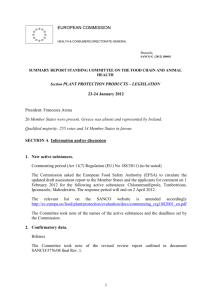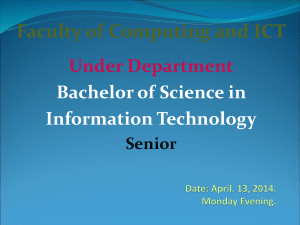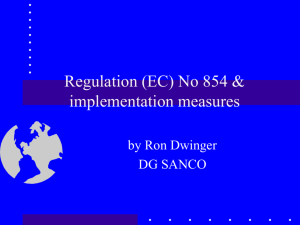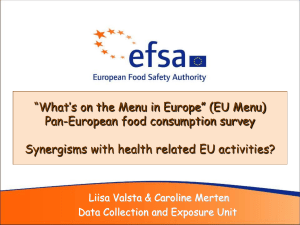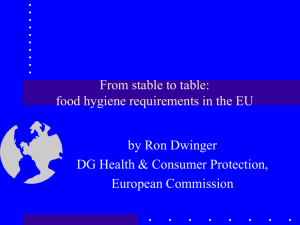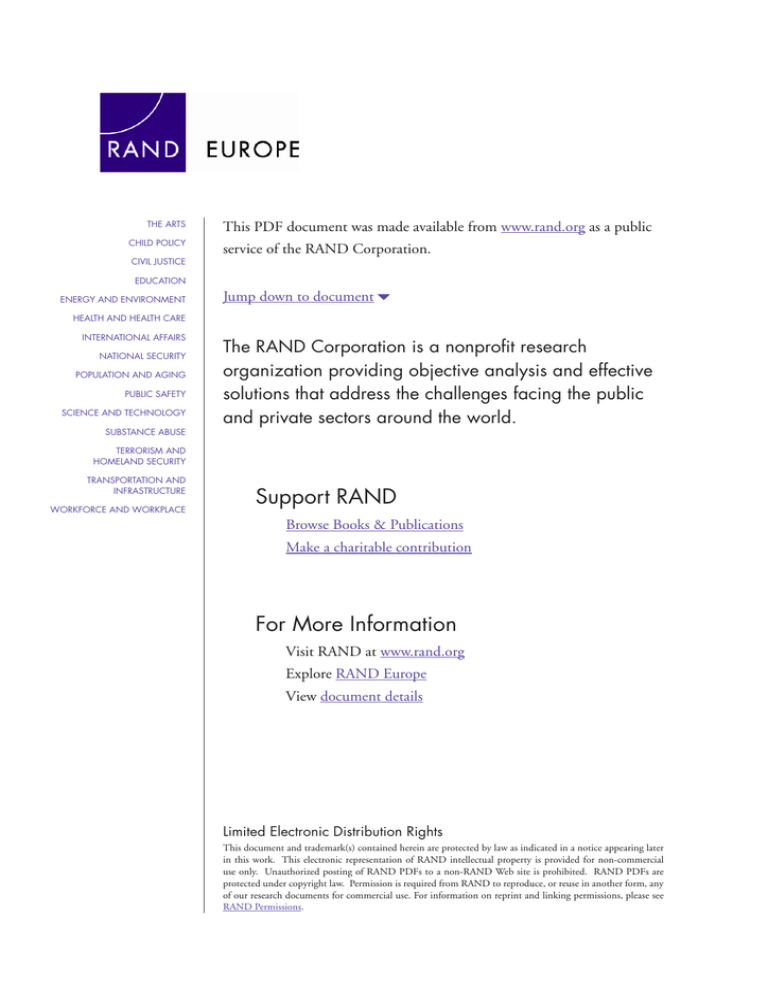
THE ARTS
CHILD POLICY
CIVIL JUSTICE
This PDF document was made available from www.rand.org as a public
service of the RAND Corporation.
EDUCATION
ENERGY AND ENVIRONMENT
Jump down to document6
HEALTH AND HEALTH CARE
INTERNATIONAL AFFAIRS
NATIONAL SECURITY
POPULATION AND AGING
PUBLIC SAFETY
SCIENCE AND TECHNOLOGY
SUBSTANCE ABUSE
The RAND Corporation is a nonprofit research
organization providing objective analysis and effective
solutions that address the challenges facing the public
and private sectors around the world.
TERRORISM AND
HOMELAND SECURITY
TRANSPORTATION AND
INFRASTRUCTURE
WORKFORCE AND WORKPLACE
Support RAND
Browse Books & Publications
Make a charitable contribution
For More Information
Visit RAND at www.rand.org
Explore RAND Europe
View document details
Limited Electronic Distribution Rights
This document and trademark(s) contained herein are protected by law as indicated in a notice appearing later
in this work. This electronic representation of RAND intellectual property is provided for non-commercial
use only. Unauthorized posting of RAND PDFs to a non-RAND Web site is prohibited. RAND PDFs are
protected under copyright law. Permission is required from RAND to reproduce, or reuse in another form, any
of our research documents for commercial use. For information on reprint and linking permissions, please see
RAND Permissions.
This product is part of the RAND Corporation technical report series. Reports may
include research findings on a specific topic that is limited in scope; present discussions of the methodology employed in research; provide literature reviews, survey
instruments, modeling exercises, guidelines for practitioners and research professionals, and supporting documentation; or deliver preliminary findings. All RAND
reports undergo rigorous peer review to ensure that they meet high standards for research quality and objectivity.
Identifying DG SANCO's
Future Challenges
2009-2014
Final Report
Tom Ling, Michael Hallsworth, Jan Tiessen,
Stijn Hoorens, Lisa Klautzer, Kai Wegrich
Prepared for Unit 02 of the European Commission's Health and Consumer
Protection Directorate-General
The research described in this report was prepared for the European Commission. The
opinions expressed in this study are those of the authors and do not necessarily reflect the
views of the European Commission.
The RAND Corporation is a nonprofit research organization providing objective analysis
and effective solutions that address the challenges facing the public and private sectors
around the world. RAND’s publications do not necessarily reflect the opinions of its
research clients and sponsors.
R® is a registered trademark.
© Copyright 2008 European Commission
All rights reserved. No part of this book may be reproduced in any form by any electronic or
mechanical means (including photocopying, recording, or information storage and retrieval)
without permission in writing from the European Commission.
Published 2008 by the RAND Corporation
1776 Main Street, P.O. Box 2138, Santa Monica, CA 90407-2138
1200 South Hayes Street, Arlington, VA 22202-5050
4570 Fifth Avenue, Suite 600, Pittsburgh, PA 15213-2665
Westbrook Centre, Milton Road, Cambridge CB4 1YG, United Kingdom
RAND URL: http://www.rand.org
RAND Europe URL: http://www.rand.org/randeurope
To order RAND documents or to obtain additional information, contact
Distribution Services: Telephone: (310) 451-7002;
Fax: (310) 451-6915; Email: order@rand.org
Executive summary
DG SANCO’s ‘Future Challenges 2009–2014’ project
The European Commission’s Directorate-General for Health and Consumer Protection
(DG SANCO) aims to “ensure food and consumer goods sold in the EU are safe, that the
EU’s internal market works for the benefit of consumers and that Europe helps protect and
improve its citizens’ health”.3 In 2006, DG SANCO embarked on a series of activities to
consider the challenges it will face in the period 2009 to 2014. RAND Europe was asked
to support this future challenges project by developing and testing three scenarios for
Europe in the near future. Scenario thinking aims to identify new options which might
otherwise have been missed; previously unnoticed risks to be managed; and foster insight
into which organizations and processes need to be influenced. Scenarios are not intended
to predict the future, but rather to provide a set of plausible yet intellectually challenging
“futures” that can aid strategic thinking and creative discussions within and between
organizations.
The process of creating the scenarios for DG SANCO involved gathering data on major
trends and key uncertainties around four areas identified by DG SANCO: governance,
confidence, changing society and globalization. This information informed an internal DG
SANCO workshop that identified eight key uncertainties that could affect DG SANCO in
2009-2014. Following this meeting, RAND Europe developed three scenarios: Galapagos,
Coral Reef and Wave. These scenarios were then tested and fine-tuned in four case study
workshops, each of which focused on a particular element that could affect the future
environment in which DG SANCO operates: nanotechnology; consumer behaviour;
ethical food consumption; and health equity. The scenario development process is outlined
in detail in Chapters Two to Six. The remainder of this Executive Summary focuses on the
questions, challenges and recommendations that emerged from the process.
Knowledge, skills, influence and risk: areas for further consideration
DG SANCO was closely involved in every stage of the scenario development and testing
process, and in October 2007 produced its DG SANCO Future Challenges Paper: 2009–
2014.4 This paper has been widely circulated, both inside and outside the Commission,
3
http://ec.europa.eu/dgs/health_consumer/weare_en.htm (accessed 12th March 2008).
4
Available at: http://ec.europa.eu/dgs/health_consumer/events/future_challenges_en.htm (accessed 12th
March 2008).
xiii
Identifying DG SANCO’s Future Challenges 2009–2014
RAND Europe
with the aim that it will enrich, validate and improve DG SANCO’s vision. Below we
present issues which emerged from the case study workshops that DG SANCO will need
to consider as it continues to further develop the Future Challenges project. The issues are
structured around four key questions:
1. What will DG SANCO need to know?
2. What skills will DG SANCO need to develop?
3. Who will DG SANCO need to influence?
4. What risks will DG SANCO need to manage?
For the sake of clarity the issues are phrased as actions that DG SANCO will need to
undertake. Although scenarios do provide indications of robust conclusions and insight
into the development of policy options, they are not predictions of the future. Therefore,
these statements should be read as reflecting the opinions of informed participants, rather
than representing predictions made by RAND Europe.
What will DG SANCO need to know?
In the futures discussed, a better understanding of consumers’ preferences, attitudes
and behaviour will be crucial to the success of DG SANCO’s policies.
DG SANCO will need a comprehensive set of international comparable data on key
areas relating to its competencies.
DG SANCO may need effective monitoring of what is happening ‘on the ground’
with regards to compliance with regulations, rather than using instrument-based
reporting on regulation.
DG SANCO will require solid in-house scientific expertise (or at least ready access
to such expertise) to adequately address the problems in policy fields where new
technologies will play a major role in the coming years, such as the regulation of
nanotechnology or pushing health technology to improve equity.
Future environments will be increasingly complex in important areas of DG
SANCO’s action, requiring a better understanding of cause–effect relationships in
important policy fields, for example in the field of health equity or on-line consumer
behaviours. It is important to note that complexity confuses causal links and
increases the risks incurred when taking action.
Intensifying international trade will have increasing implications for how DG
SANCO delivers its aims; and therefore access to expertise in this area will be
needed. It will be particularly important to understand how China, India and Russia
will deploy their increasing influence in the arena of global regulations and
standards.
xiv
RAND Europe
Executive summary
What skills will DG SANCO need to develop?
DG SANCO has to become better at prioritizing its work: each scenario (in
different ways) would require a clear focus on the unique contribution DG SANCO
could make.
DG SANCO will need to develop its communication skills further. The scenario
work suggested that social change, and the development of new communications
media, will require a rapidly evolving communications strategy. In these futures, DG
SANCO should especially learn how to use new communication channels
effectively.
DG SANCO needs to think how it “sells” its policies because in the emerging
environment successful organizations will require a “license to operate” beyond their
formal or legal powers. This will require strategic skills to understand the attitude of
actors, coupled with the ability to select exactly the right communication method.
Analytical skills will become increasingly important for DG SANCO’s work, in
order to locate, filter and analyse large amounts of information into knowledge that
is useful to the organization.
To promote rapid learning and feedback, it will be necessary to evaluate policies and
projects; the necessary skills must be developed within DG SANCO so its staff can
either conduct evaluations themselves or become knowledgeable commissioners of
external evaluations.
Understanding the complexities of some regulatory fields (including the possibilities
and varieties of soft and hard regulation) will require further analysis.
To be successful in the European multi-actor governance system, DG SANCO will
need networking skills and strong cooperation and consensus-building skills.
Who will DG SANCO need to influence?
The most important actors to be influenced will be the Member States, their
governments and particular authorities within them.
Cooperation with international organizations such as World Health Organization
and World Trade Organization will be of increased importance to DG SANCO,
who should attempt to influence the agendas (and decisions) of these organizations
more strongly.
Politicians will remain in charge of DG SANCO and therefore it will be important
to provide them with the evidence and arguments they can best use. Given that
there may be a considerable period between initiating and realizing actions,
politicians need to prioritize and maintain their support for an issue.
Other Directorates-General (and the wider institutions of the EU) will continue to
be closely linked to DG SANCO’s activities and thus remain important actors to
xv
Identifying DG SANCO’s Future Challenges 2009–2014
RAND Europe
influence. It is vital that DG SANCO is recognized as a “credible operator” within
the European Commission.
DG SANCO should focus more on the local (sub-Member State) level. By aligning
itself with trusted local authorities and actors, DG SANCO may increase its
credibility and trustworthiness. Engaging with local grassroots organizations and
citizens might also be a way to improve the delivery of DG SANCO’s aims.
Every four years, DG SANCO should take an action, such as tackling mobile phone
roaming tariffs, which is widely popular and is publicized as a European Union
intervention.
Although the group of relevant institutional actors to influence will remain rather
stable over time, DG SANCO should become more strategic in developing:
key targeted stakeholders, rather than addressing all – providing
that this targeting is made clear and linked to DG SANCO’s
remit
strong alliances for specific policy issues.
What risks will DG SANCO need to manage?
External shocks, originating from the global economy, other global actors or global
disasters and disease outbreaks, may have to be managed by DG SANCO at some
point. While local or regional threats might be dealt with at a lower level, DG
SANCO will need to be prepared to address global, external shocks.
DG SANCO needs to ensure that it has high quality information on the issues it is
addressing, and will need to back up its decisions with a more exacting burden of
proof, fit its activities to the information it has available, or adopt more adaptive
recommendations.
The future development of the EU institutions, whether in the direction of more or
less integration, constitutes a major risk to be managed by DG SANCO.
DG SANCO will need to guard against the danger of overreaching its capacity to
deliver. DG SANCO will come under pressure to deliver across a range of areas but
adopting too many goals, or setting these goals too high, might lead to failure and
public frustration.
DG SANCO has to manage the risk of being held responsible for problems which
lie outside its competencies, but which may be attributed to DG SANCO.
Across all the scenarios there was a perceived risk that DG SANCO may become
crisis-driven rather than strategic in its behaviour.
xvi
RAND Europe
Executive summary
Complex strategic problems for DG SANCO to address
Using the material generated by workshop participants, RAND Europe has identified six
complex strategic problems that DG SANCO will need to address. These are issues where
DG SANCO must select from a wide variety of mutually exclusive decisions; prioritize and
make trade-offs between its various responsibilities; or develop a sophisticated response to
multi-faceted and mercurial problems.
DG SANCO could find itself gradually doing more and increasingly diverse things.
Should it aim to excel in diverse fields or deliver benefits where it has a unique
advantage? Is it possible to develop a coherent policy portfolio that balances growth
and maintaining delivery for existing areas?
DG SANCO is likely to occupy a more complex regulatory environment. Should it
aim to set the standards to be met by self- and external regulation or should it take
action to regulate?
It is very likely that the quantity and complexity of information generated inside and
outside DG SANCO will increase. This increase will present challenges of
communication and coordination for DG SANCO both inside and outside the
organization. How will DG SANCO establish efficient coordination and
communications practices?
Consumers’ needs and desires are both rapidly changing and becoming more
heterogeneous, which implies that a light-footed and responsive process is needed.
How will this be squared with the Commission-wide requirements of probity,
fairness and so forth?
Is DG SANCO prepared for a further globalization of activities that may produce
more change in the next ten years than in the past thirty?
The possible changes identified through the Future Challenges workshops might
overwhelm any organization’s capacity to change whilst maintaining delivery of core
services. How could this be avoided?
Recommendations on taking the Future Challenges project further
RAND Europe has provided recommendations on how DG SANCO can further develop
the knowledge and awareness generated by the Future Challenges 2009–2014 project.
These recommendations are focused around: how to use scenarios in organizations; the use
of workshops; new ways of thinking about Impact Assessments.
Using scenarios
Scenarios can help to communicate the uncertainty that organizations face, provide a
shared reference point for assessing an organization’s options, and support risk assessments
and policy options. Given this range of applications, it is important for the organization to
be clear about the effects it intends to induce. Possibilities include:
xvii
Identifying DG SANCO’s Future Challenges 2009–2014
RAND Europe
informing specific decisions
providing input to decision-making frameworks
supporting indirect decision-making, such as clarifying an issue’s importance or
framing a decision agenda
engendering cultural change, for example by shaking up habitual thinking and
stimulating creativity
creating a ‘safer space’ in which to engage stakeholders in a strategic debate.
Nevertheless, significant gaps exist between much current scenario practice and the
potential contributions of scenarios. Public sector organizations also face particular
constraints relating to accountability arrangements and political responsibilities (Ling,
2002). Their successful use therefore requires clarity of purpose, effective facilitation, and
sensitivity to the wider architecture of accountability and political responsibility. More
specifically, DG SANCO should be aware of the following challenges.
Participants in a scenario exercise may not always agree on the interpretation of their
scenarios.
Scenarios must be presented in a way that engages with the particular needs of
specific decision-makers and makes clear their relation to the world of practical
action.
It may be difficult to establish what future decisions will be within and what ones
beyond the control of DG SANCO.
The most important uncertainties affecting a decision have to do with the effects
(both foreseen and unforeseen) of various proposed policy actions, which is itself
uncertain.
After an interesting “strategic conversation”, members of an organization may return
to “business as usual”.
The use of workshops
Holding further creative scenario workshops would help to embed strategic thinking
deeper into DG SANCO’s processes. They could help to develop an understanding that
strategic thinking is an iterative process in which the needs and priorities of stakeholders,
the vision and goals of the organization, and the implications of external changes are held
in balance to inform decisions. Workshops could also allow participants to take a fresh
look at DG SANCO’s vision and the expectations of its stakeholders.
Workshops can explore vertical strategy (for example, policy areas); horizontal strategy (for
example, cross-cutting issues like communications); generate new policy ideas; or test
existing strategies. Section 7.7.2 provides more details on how the workshops could be
structured according to their purposes.
xviii
RAND Europe
Executive summary
Impact Assessments
The current Commission-wide approach to Impact Assessments focuses on examining a
variety of options in a single (hypothetical) future. In this approach, consideration of
uncertainty focuses on the policy options rather than on the future. An ex ante evaluation
informed by futures methodology would tend to reverse this and examine the impact of a
single option in a range of plausible futures. By introducing futures thinking in this way to
ex ante evaluation, it would be possible to institutionalize scenarios within a DirectorateGeneral as part of the Impact Assessment process. Naturally, any such scenarios would
need to consider elements that reflect the entire range of a Directorate-General’s activities.
xix

